Mesoamerican architecture
Mesoamerican architecture is the set of architectural traditions produced by pre-Columbian cultures and civilizations of Mesoamerica, traditions which are best known in the form of public, ceremonial and urban monumental buildings and structures. The distinctive features of Mesoamerican architecture encompass a number of different regional and historical styles, which however are significantly interrelated. These styles developed throughout the different phases of Mesoamerican history as a result of the intensive cultural exchange between the different cultures of the Mesoamerican culture area through thousands of years. Mesoamerican architecture is mostly noted for its pyramids which are the largest such structures (outside of Ancient Egypt and the Chola Empire).
One interesting and widely researched topic is the relation between cosmovision, religion, geography, and architecture in Mesoamerica. Much seems to suggest that many traits of Mesoamerican architecture were governed by religious and mythological ideas. For example, the layout of most Mesoamerican cities seem to be influenced by the cardinal directions and their mythological and symbolic meanings in Mesoamerican culture.
Another part of Mesoamerican architecture is its iconography. The monumental architecture of Mesoamerica was decorated with images of religious and cultural significance, and also in many cases with writing in some of the Mesoamerican writing systems. Iconographic decorations and texts on buildings are important contributors to the overall current knowledge of pre-Columbian Mesoamerican society, history and religion.

Chronology
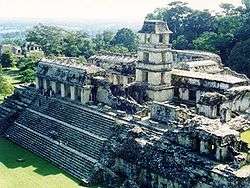



The following tables shows the different phases of Mesoamerican Architecture and archeology and correlates them with the cultures, cities, styles and specific building that are notable from each period.
| Period | Timespan | Important cultures, cities, structures and styles |
|---|---|---|
| Pre-Classic(Formative) | BC 2000–100 | Gulf Coast cultures, Olmec, Monte Alto Culture |
| Early Pre-Classic | BC 2000–1000 | Olmec centers San Lorenzo Tenochtitlan, Chalcatzingo, San José Mogote, La Mojarra Steala 12 |
| Middle Pre-Classic | BC 1000–400 | Late Olmec and Early Maya, Izapa, La Venta, Tres Zapotes, Usulután ceramics, Nakbé, Lamanai, Xunantunich Naj Tunich Cave, El Mirador, Kaminaljuyú |
| Late Pre-Classic | BC 400 – 200 AD | Maya, Teotihuacan and Zapotec, Teuchitlan Tradition formative periods, Teotihuacan, Uaxactún, Tikal, Edzná, Monte Albán I & II, Pyramid of the Sun, Guachimontones |
| Classic | 200–900 AD | Classic Maya Centers, Teotihuacan, Zapotecs, Teuchitlan Tradition |
| Early Classic | AD 200–600 | Teotihuacan apogee, Monte Albán III, Palenque, Copán, Classic Veracruz culture, Talud-tablero, Hieroglyphic stairs of Copán, Tomb of Pacal the Great, |
| Late Classic | AD 600–900 | Xochicalco, Cacaxtla, Cancuen, Quiriguá, Uxmal, Toniná, Classic Veracruz Culture, Puuc style, Rio Bec style, Cobá, Yaxchilan Lintel 24 |
| Post-Classic | AD 900–1519 | Maya Itzá, Chichen Itza, Mayapan, Tayasal, and Kowoj Topoxte, Toltec, Purépecha, Mixtec, Totonac |
| Early Post-Classic | AD 900–1200 | Cholula, Tula, Mitla, El Tajín, Tulum, Kaminaljuyú |
| Late Post-Classic | AD 1200–1519 | Aztec, Tenochtitlan, Templo Mayor, Tzintzuntzan, Quiché Utatlán, Kaqchikel Iximche and Mam Zaculeu, Mayan, Utatlán, Cempoala |
Urban Planning and Cosmovision
Cosmos and its replication
Symbolism
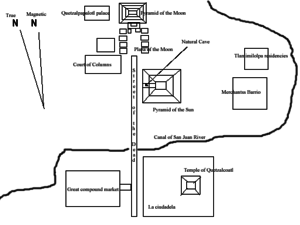
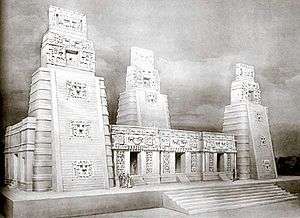
An important part of the Mesoamerican religious system was replicating their beliefs in concrete tangible forms, in effect making the world an embodiment of their beliefs.[1] This meant that the Mesoamerican city was constructed to be a microcosm, manifesting the same division that existed in the religious, mythical geography—a division between the underworld and the human world. The underworld was represented by the direction north and many structures and buildings related to the underworld, such as tombs, are often found in the city's northern half. The southern part represented life, sustenance and rebirth and often contained structures related to the continuity and daily function of the city state, such as monuments depicting the noble lineages, or residential quarters, markets etc. Between the two halves of the north/south axis was the plaza, often containing stelae resembling the world tree the Mesoamerican axis mundi, and a ballcourt which served as a crossing point between the two worlds.
Some Mesoamericanists argue that in religious symbolism the Mesoamerican monumental architecture pyramids were mountains, stelae were trees, and wells, ballcourts and cenotes were caves that provided access to the underworld.[2]
Orientation
Mesoamerican architecture is often designed to align to specific celestial events. Pyramids, temples, and other structures were designed to achieve special lighting effects on the equinoxes or on other days important in the Mesoamerican cosmovision. A famous example is the "El Castillo" pyramid at Chichen Itza, whose stairway catches the light so as to cause the carved serpents lining the sides to appear to writhe.
Much Mesoamerican architecture is also aligned to roughly 15° east of north.[3] Vincent H Malmstrom has argued[4] that this is because of a general wish to align the pyramids to face the sunset on August 13, which was the beginning date of the Maya Long Count calendar.
The Plaza
At the heart of the Mesoamerican city were large plazas surrounded by the most important governmental and religious buildings, such as the royal acropolis, great pyramid temples and occasionally ballcourts.
The Main Pyramids
Often the most important religious temples sat atop the towering pyramids, presumably as the closest place to the heavens. While recent discoveries point toward the extensive use of pyramids as tombs, the temples themselves seem to rarely, if ever, contain burials. Residing atop the pyramids, some of over two-hundred feet, such as that at El Mirador, the temples were impressive and decorated structures themselves. Commonly topped with a roof comb, or superficial grandiose wall, these temples might have served as a type of propaganda.
The Ball court

The Mesoamerican ballgame ritual was a symbolic journey between the underworld and the world of the living, and many ball courts are found in the mid-part of the city functioning as a connection between the northern and southern halves of the city.[5] All but the earliest ball courts are masonry structures. Over 1300 ball courts have been identified, and although there is a tremendous variation in size, they all have the same general shape: a long narrow alley flanked by two walls with horizontal, sloping, and sometimes vertical faces. The later vertical faces, such as those at Chichen Itza and El Tajin, are often covered with complex iconography and scenes of human sacrifice (see photo here).
Although the alleys in early ball courts were open-ended, later ball courts had enclosed end-zones, giving the structure an ![]() -shape when viewed from above. The playing alley may be at ground level, or the ball court may be "sunken".
-shape when viewed from above. The playing alley may be at ground level, or the ball court may be "sunken".
Ball courts were no mean feats of engineering. One of the sandstone stones on El Tajin's South Ball court is 11 m long and weighs more than 10 tons.[6]
Residential Quarters and Palaces
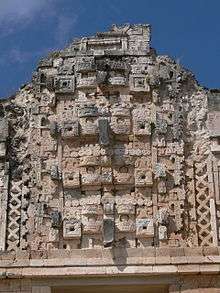
Large and often highly decorated, the palaces usually sat close to the center of a city and housed the population's elite. Any exceedingly large royal palace, or one consisting of many chambers on different levels might be referred to as an acropolis. However, often these were one-story and consisted of many small chambers and typically at least one interior courtyard; these structures appear to take into account the needed functionality required of a residence, as well as the decoration required for their inhabitants stature. Archaeologists seem to agree that many palaces are home to various tombs. At Copán, beneath over four-hundred years of later remodeling, a tomb for one of the ancient rulers has been discovered and the North Acropolis at Tikal appears to have been the site of numerous burials during the Terminal Pre-classic and Early Classic periods.
Building materials
The most surprising aspect of the great Mesoamerican structures is their lack of many advanced technologies that would seem to be necessary for such constructions. Lacking metal tools, Mesoamerican architecture required one thing in abundance: manpower. Yet, beyond this enormous requirement, the remaining materials seem to have been readily available. They most often utilized limestone, which remained pliable enough to be worked with stone tools while being quarried, and only hardened once when removed from its bed. In addition to the structural use of limestone, much of their mortar consisted of crushed, burnt, and mixed limestone that mimicked the properties of cement and was used just as widely for stucco finishing as it was for mortar. However, later improvements in quarrying techniques reduced the necessity for this limestone-stucco as their stones began to fit quite perfectly, yet it remained a crucial element in some post and lintel roofs. A common building material in central Mexico was tezontle (a light, volcanic rock). It was common for palaces and monumental structures to be made of this rough stone and then covered with stucco or with a cantera veneer. Very large and ornate architectural ornaments were fashioned from a very enduring stucco (kalk), especially in the Mayan region, where a type of hydraulic limestone cement or concrete was also used.[7]In the case of the common houses, wooden framing, adobe, and thatch were used to build homes over stone foundations. However, instances of what appear to be common houses of limestone have been discovered as well. Buildings were typically finished with high slanted roofs usually built of wood or thatch although stone roofs in these high slant fashions are also used rarely.
Styles
Megalithic
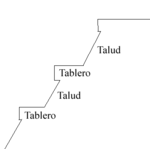
An architectural construction technique that employs large dry-laid limestone blocks (ca. 1 m x 50 cm x 30 cm) covered with a thick layer of stucco. This style was common in the northern Maya lowlands from the Preclassic until the early parts of the Early Classic.
Talud-tablero
Pyramids in Mesoamerican were platformed pyramids and many used a style called talud-tablero, which first became common in Teotihuacan. This style consists of a platform structure, or the "tablero," on top of a sloped "talud". Many different variants on the talud-tablero style arose throughout Mesoamerica, developing and manifesting itself differently among the various cultures.
Classic Period Maya styles
Palenque, Tikal, Copan, Tonina, the corbeled arch.
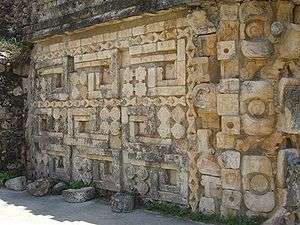
"Toltec" Style
Chichén Itzá, Tula Hidalgo, chacmools, Atlantean figures, Quetzalcoatl designs.
Puuc
So named after the Puuc hills in which this style developed and flourished during the latter portion of the Late Classic and throughout the Terminal Classic in the northern Maya lowlands, Puuc architecture consists of veneer facing stones applied to a concrete core. Two façades were typically built, partitioned by a ridge of stone. The blank lower façade is formed by flat cut stones and punctuated by doorways. The upper partition is richly decorated with repeating geometric patterns and iconographic elements, especially the distinctive curved-nosed Chaac masks. Carved columnettes are also common.
Technology


Corbelled Arch
Mesoamerican cultures never invented the keystone, and so were unable to build true arches, but instead all of their architecture made use of the "false" or Corbelled arch. These arches are built without centering and can be built without support, by corbelling regularly the horizontal courses of the wall masonry. This type of arch supports much less weight than a true arch.
However, recent work by engineer James O'Kon suggests the Mesoamerican "arch" is technically not a corbelled arch at all but a trapezium truss system. Moreover, unlike a corbelled arch, it does not rely on overlapping layers of blocks but cast-in-place concrete often supported by timber thrust beams. Computer analysis reveals this to be structurally superior to a curved arch[8]
UNESCO world heritage sites
A number of important archeological sites representing Mesoamerican Architecture have been categorized as "world heritage sites" by the UNESCO.[9]
El Salvador
- Maya site of Joya de Ceren
Honduras
- Maya Site of Copan
Guatemala
Mexico
- Pre-Hispanic City and National Park of Palenque
- Pre-Hispanic Town of Uxmal
- Pre-Hispanic City of Teotihuacan
- Historic Centre of Oaxaca and Archaeological Site of Monte Alban
- Pre-Hispanic City of Chichen Itza
- Archaeological Monuments Zone of Xochicalco, Morelos
- El Tajin, Pre-Hispanic City of Veracruz
- Ancient Maya City of Calakmul, Campeche
See also
- Maya architecture
- Maya city
- Buildings and structures in Mesoamerica
- Triadic pyramid
Notes
- ↑ Mary Miller and Karl Taube, introduction to "The Gods and Symbols of Ancient Mexico and the Maya" pp. 30.
- ↑ Mary Miller and Karl Taube write about this in their introduction to "The Gods and Symbols of Ancient Mexico and the Maya" pp. 31, they attribute this interpretation to Epigrapher David Stuart. American archeologist James E. Brady have done extensive research on importance of Caves in Mesoamerican culture. The title of the famous book "Forest of Kings" by Mayanist Linda Schele also alludes to the Maya belief that stelae represent trees, especially the world tree, axis mundi of the mayan cosmos.
- ↑ Aveni and Gibbs. Other researchers give other estimates or averages, but there is a remarkable consistency across time and space to this general orientation.
- ↑ In Chapter 22 of Archaeoastronomy in the Americas, edited by Ray A. Williamson, Ballena Press/Center for Archaeoastronomy, 1981, pp.249-261, which can also be found at his website. See also John Q Jacobs article for more information on the alignments of Mesoamerican Cities
- ↑ Muriel Porter Weaver describes this on page 226-228 of the third edition of "The Aztecs, Maya and their Predecessors".
- ↑ Wilkerson, p. 50.
- ↑ James A O'Kon, The Lost Secrets of Maya Technology Pompton Plaines: Career Press 2012, pp.114-123
- ↑ James A O'Kon, The Secrets of Maya Technology, Pompton PLains: New Page, 2012, pp. 149-150
- ↑ The entire list of UNESCO world Heritage Sites can be found at their website
Further reading
- Bernal, I, Coe, M, et al., (1973). The Iconography of Middle American sculpture. New York: The Metropolitan Museum of Art.
| Wikimedia Commons has media related to Mesoamerican architecture. |
.jpg)